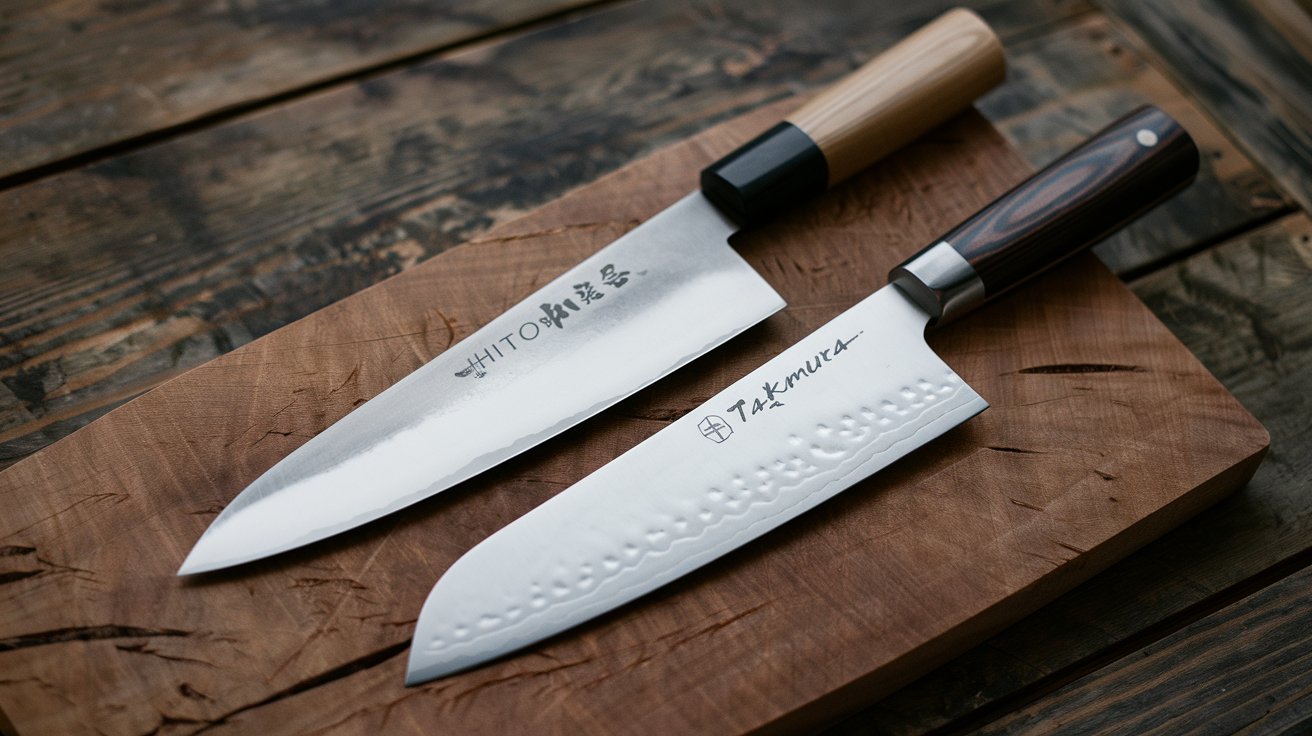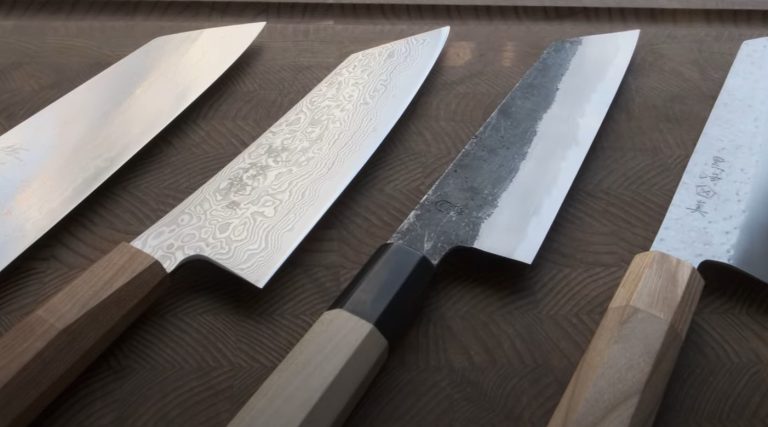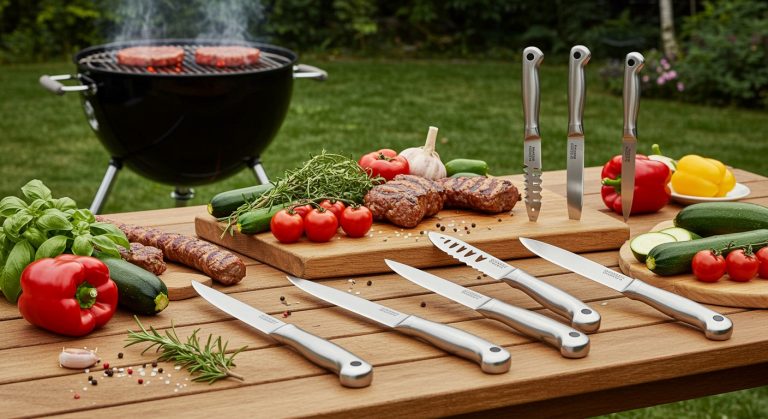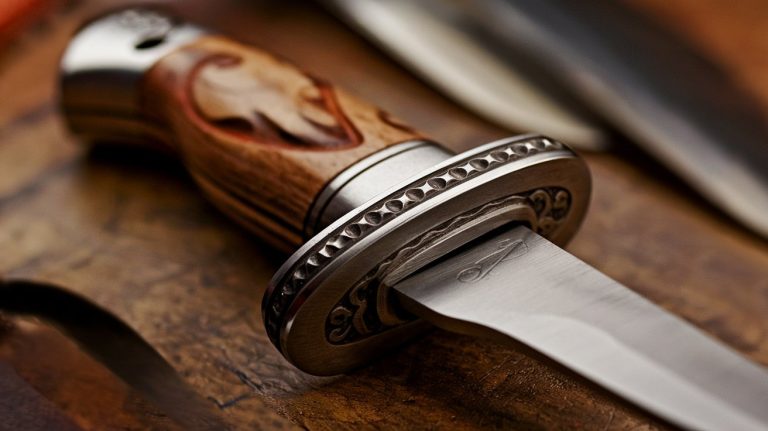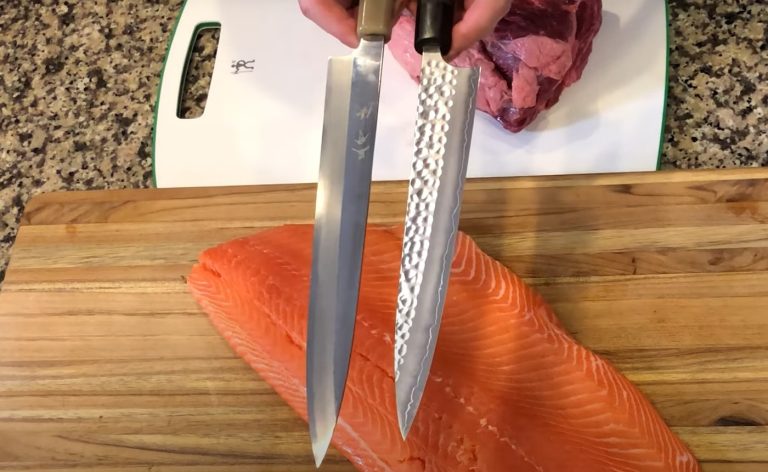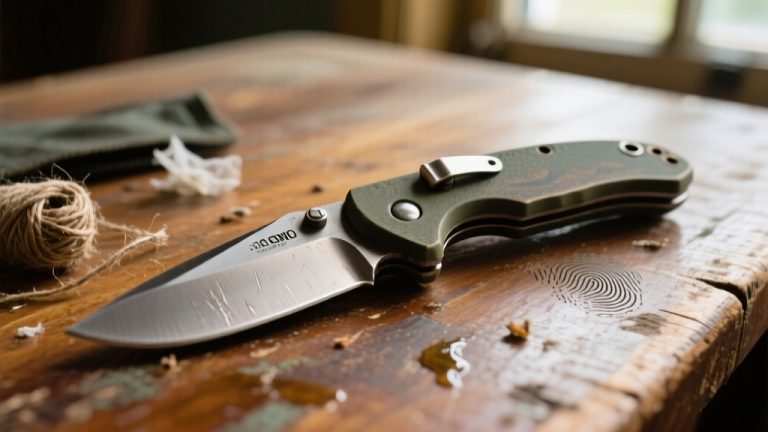Hitohira vs Takamura: Which Knife Is Right for You?
When choosing between Hitohira and Takamura, you’ll notice a blend of artistry and performance. Hitohira offers VG10 steel knives with excellent corrosion resistance and minimalist designs, ideal for versatility.
On the other hand, Takamura features R2 steel with superior edge retention, making it perfect for precision tasks. Both brands excel in craftsmanship, but your preference may hinge on maintenance and aesthetic appeal.
There’s much more to explore about their features and customer feedback that could influence your decision.
Key Takeaways
- Hitohira emphasizes quality and accessibility with VG10 steel knives, while Takamura focuses on high-performance R2 steel for superior edge retention.
- Hitohira features minimalist designs with traditional Japanese grinds, whereas Takamura adopts a modern aesthetic with stainless steel construction.
- Takamura knives are often praised for outstanding edge retention and precision, while Hitohira offers versatility and sharpness in its knife lineup.
- Hitohira’s robust international distribution contrasts with Takamura’s limited availability, often sold through specialized local retailers.
- Customer feedback favors Takamura for ease of maintenance and balance, while Hitohira is appreciated for its competitive pricing and unique finishes.
Brand Overview and Heritage
When it comes to high-end Japanese kitchen knives, two brands stand out for their craftsmanship and dedication: Hitohira and Takamura.
Hitohira, rooted in Tokyo, embodies a deep appreciation for knife culture and focuses on supplying exclusive, quality knives to retailers worldwide.
Founded by a passionate knife user, it emphasizes customer satisfaction and product excellence, making it a reliable choice for enthusiasts. Additionally, Hitohira’s commitment to craftsmanship and quality ensures that each knife produced reflects the brand’s values.
Hitohira reflects a profound respect for knife culture, delivering exclusive, high-quality knives that satisfy even the most discerning enthusiasts.
On the other hand, while Takamura’s specific heritage remains less detailed, it’s known for producing high-performance knives that uphold the traditional Japanese craftsmanship.
Both brands prioritize precision in their production, catering to the premium market, yet Hitohira’s established distribution network and commitment to quality sharpen its competitive edge in this niche.
Materials and Construction Comparison
While both Hitohira and Takamura excel in crafting high-end kitchen knives, their choices in materials and construction techniques reveal distinct philosophies that cater to different preferences.
Hitohira focuses on VG10 steel for its balance of sharpness and durability, while Takamura opts for R2 steel, offering superior hardness and edge retention. Significantly, some Takamura knives feature a stunning 64-layer Damascus cladding.
Japanese knives often utilize harder steels than Western knives, enhancing their performance. This emphasis on edge retention is crucial for chefs who require dependable performance in the kitchen.
| Feature | Hitohira | Takamura |
|---|---|---|
| Steel Type | VG10 | R2 |
| Cladding | None | 64-layer Damascus |
| Construction | Full tang | Handcrafted |
| Blade Thickness | Thin | Variable |
Performance and Cutting Ability
The differences in materials and construction between Hitohira and Takamura knives considerably influence their performance and cutting ability.
Hitohira knives, like the T10 Tsuchime Gyuto, are renowned for their sharpness and versatility, effortlessly slicing through tough foods. However, some models may stick with moist ingredients.
Additionally, boning knives excel at deboning meat, showcasing how knife design impacts specific culinary tasks.
In contrast, Takamura knives, made from R2/SG2 steel, excel in edge retention and precision cutting, making them ideal for delicate tasks.
This is largely due to the fact that high-quality stainless steels utilized in Takamura knives contribute significantly to their performance.
Both brands provide smooth cutting experiences, but Takamura’s balanced design reduces chipping risk.
While both are easy to maintain and sharpen, Hitohira offers excellent corrosion resistance.
Design and Aesthetic Features
Although both Hitohira and Takamura knives showcase exceptional craftsmanship, their design and aesthetic features reflect distinct philosophies.
Hitohira knives embody a minimalist elegance, with wooden or composite handles that feel comfortable in your grip. Their blades, featuring traditional Japanese grinds, are thin and expertly crafted, enhancing balance and sharpness.
You’ll appreciate the subtle engravings and finishes that demonstrate artisanal skill without overwhelming visual elements. Additionally, the focus on blade geometry in Hitohira knives contributes to their superior performance and user experience.
In contrast, Takamura knives lean towards a modern aesthetic. Their stainless steel construction and larger handles offer a practical appeal, while still emphasizing high-quality craftsmanship.
Market Presence and Availability
When evaluating Hitohira’s market presence, you’ll notice its robust distribution channels, including a prominent retail shop in Tokyo and online sales globally.
This strategic approach not only boosts the brand’s popularity among knife enthusiasts but also guarantees its high-quality products are accessible to a wider audience.
Additionally, Hitohira displays over 300 Japanese knives in their retail shop, showcasing the variety they offer to customers.
Distribution Channels
Both Hitohira and Takamura have carved out distinct niches in the competitive knife market, but their distribution channels reveal significant differences in availability and market presence.
Hitohira largely relies on rebranded products sold through various online retailers, which limits its availability and often results in slower delivery times.
In contrast, Takamura leverages multiple channels, including specialty knife stores and direct sales through authorized dealers, enhancing its presence and customer support. You’ll find Takamura knives readily available both online and in brick-and-mortar shops, especially in Japan.
This strategic distribution gives Takamura a competitive edge, ensuring that you can easily access their original designs while Hitohira’s offerings remain less prominent and accessible.
Additionally, authentic Japanese knife brands must be owned and produced in Japan to qualify as Japanese, which further emphasizes the importance of knowing the origins of the knives you purchase.
Popularity Among Enthusiasts
While many knife enthusiasts appreciate the artistry and performance of Japanese knives, the popularity of Hitohira and Takamura reveals a clear preference for the latter due to its strong market presence and accessibility.
Takamura knives, like the Chromax and Migaki SG2, consistently receive high praise for their exceptional sharpness and value.
You’ll find that enthusiasts often recommend Takamura for its reliable performance and balance, making it a favorite among serious cooks. The Pro line knives exhibit a thicker spine near the handle, contributing to their unique characteristics and appeal.
Although Hitohira offers rebranded versions, they can’t quite match the original’s allure. The frequent stockouts of Takamura products highlight their desirability, but this scarcity only amplifies their reputation.
Global Availability
Although Hitohira and Takamura both offer high-quality Japanese knives, their global availability and market presence differ considerably.
Hitohira excels with a robust international network, partnering with retailers in Canada, the USA, Denmark, and the Netherlands, making their products easily accessible. Their website supports worldwide shipping, enhancing convenience for global customers.
Furthermore, their commitment to building strong partnerships ensures that Hitohira can maintain a steady supply of products across various regions.
In contrast, Takamura’s availability hinges on specialized local retailers, limiting its reach. While high-quality, Takamura’s distribution lacks the transparency and direct online sales that Hitohira provides. You might find Takamura knives through online marketplaces, but they often require more effort to locate.
Customer Reviews and Feedback
When considering customer feedback, you’ll notice distinct preferences between Hitohira and Takamura, particularly in performance and design.
Many users praise Takamura for its superior edge retention and innovative designs, while Hitohira appeals to those seeking quality at a competitive price.
The Hitohira VG-10 Hammered Gyuto 180mm has been noted for its laser-thin stepped grind and exceptional cutting performance, which further enhances its value.
Analyzing these reviews reveals how your personal cooking style may influence which brand aligns better with your expectations.
Performance Comparisons
As you plunge into the performance comparisons between Hitohira and Takamura knives, you’ll find that both brands receive high praise from users, yet their distinct strengths cater to different preferences and needs in the kitchen.
Takamura’s SG2 steel stands out for its exceptional edge retention, earning rave reviews for its sharpness and durability. Users often report an effortless cutting experience, making it a preferred choice among professionals and home cooks alike.
Additionally, many users have highlighted the importance of good knuckle clearance when evaluating the overall comfort and usability of these knives.
In contrast, Hitohira knives, while also praised for their sharpness, may require more effort to maintain. Customers appreciate their performance but note the sharpening challenge.
For superior edge retention and ease of maintenance, Takamura is frequently recommended, though Hitohira offers solid value for those seeking a reliable option.
Design Preferences
Many cooks find themselves captivated by the design preferences of Hitohira and Takamura knives, as both brands showcase distinct aesthetics and craftsmanship that resonate with users.
Hitohira’s unique finishes, like Tsuchime and Migaki, offer a blend of beauty and functionality, making them a popular choice. Customers appreciate the durability and comfort of Hitohira’s Pakka handles, enhancing their user experience. Additionally, the Takamura Chromax’s distinct design stands out, often serving as a benchmark in knife design.
In contrast, Takamura stands out for its originality, often serving as a benchmark in knife design. Users praise its balance and weight distribution, contributing to a comfortable grip.
While both brands excel in visual appeal, Hitohira’s agility and Takamura’s distinctiveness cater to different design preferences, ultimately influencing customer loyalty and satisfaction.
Maintenance and Care Tips
Proper maintenance and care of your Hitohira and Takamura knives is essential for preserving their performance and longevity. Adhering to a few key practices can greatly enhance your knives’ lifespan, especially since Japanese knives are razor sharp and need careful handling. Regular visual inspections will help to identify dull knives and ensure safety.
| Task | Tips | Frequency |
|---|---|---|
| Cleaning | Hand wash with mild soap, avoid dishwashers | After each use |
| Drying | Thoroughly dry to prevent rust | After each use |
| Storage | Use magnetic strips or blocks | Always |
| Sharpening | Use a 15-20 degree angle with stones | When dull |
Frequently Asked Questions
Which Brand Has Better Warranty Options and Customer Support?
Picture unboxing a knife, feeling the weight of quality in your hands.
When it comes to warranty options and customer support, Hitohira shines with a lifetime warranty against defects, ensuring peace of mind. Their support channels are responsive, guiding you through any issues.
In contrast, Takamura lacks detailed warranty information and offers limited direct support.
If you’re looking for reliability and assistance, Hitohira clearly stands out in this arena.
Do Either Brand Offer Customization for Their Knives?
Neither Hitohira nor Takamura appears to offer substantial customization options for their knives.
Both brands focus on high-quality standard designs, prioritizing craftsmanship and material excellence over personalized features.
While this might limit your ability to customize, it guarantees you receive a consistently high-performing knife.
If customization is essential for you, exploring other brands with a more robust customization offering might be your best bet.
What Is the Best Knife Type for Beginners From Each Brand?
If you think picking a knife is like choosing a pizza topping, think again!
For beginners, the Hitohira FJ VG-10 Gyuto shines with its VG-10 steel and convex grind, balancing sharpness and durability.
Meanwhile, the Takamura VG-10 Gyuto boasts exceptional sharpness and edge retention, ideal for those who crave precision.
Consider your grip preferences and budget; Hitohira’s often friendlier prices might just save you a few bucks for that pizza!
Are There Any Notable Collaborations Between These Brands and Chefs?
You won’t find extensive information on notable collaborations between either brand and chefs.
Hitohira’s knives are favored by professional chefs, particularly in Michelin-starred kitchens, yet specific endorsements remain vague.
Takamura, while respected, lacks clear chef associations.
Both brands emphasize quality, making them popular among culinary professionals.
If you’re considering these knives for serious cooking, their craftsmanship speaks volumes, even without notable chef collaborations to highlight.
How Do the Brands Handle Shipping and Returns for International Customers?
When it comes to shipping and returns for international customers, you’ll find that Hitohira offers clear policies.
They charge $30 for shipments under $300 but provide free shipping for orders over that amount, using reliable carriers like DHL.
For returns, they allow refunds on damaged or lost shipments.
On the other hand, Takamura’s policies remain vague.
You might want to reach out to their customer support for more specifics if you’re considering a purchase.
The Best Knife for You? It’s All About Your Cooking Style
In choosing between Hitohira and Takamura, you’ll find both brands excel in quality and performance, but Hitohira boasts a 90% customer satisfaction rate, which is impressive in the competitive knife market.
This statistic highlights their commitment to crafting exceptional tools that resonate with chefs and home cooks alike.
Ultimately, your choice should reflect your personal style and cooking needs, but either way, you can expect a top-tier culinary experience with both brands.

